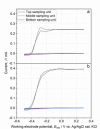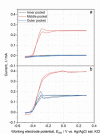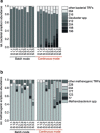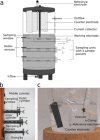Redox Potential Heterogeneity in Fixed-Bed Electrodes Leads to Microbial Stratification and Inhomogeneous Performance
- PMID: 33387375
- PMCID: PMC7986606
- DOI: 10.1002/cssc.202002611
Redox Potential Heterogeneity in Fixed-Bed Electrodes Leads to Microbial Stratification and Inhomogeneous Performance
Abstract
Bed electrodes provide high electrode area-to-volume ratios represent a promising configuration for transferring bioelectrochemical systems close to industrial applications. Nevertheless, the intrinsic electrical resistance leads to poor polarization behavior. Therefore, the distribution of Geobacter spp. and their electrochemical performance within exemplary fixed-bed electrodes are investigated. A minimally invasive sampling system allows characterization of granules from different spatial locations of bed electrodes. Cyclic voltammetry of single granules (n=63) demonstrates that the major share of electroactivity (134.3 mA L-1 ) is achieved by approximately 10 % of the bed volume, specifically that being close to the current collector. Nevertheless, analysis of the microbial community reveals that Geobacter spp. dominated all sampled granules. These findings clearly demonstrate the need for engineered bed electrodes to improve electron exchange between microorganisms and granules.
Keywords: 3D printing; cyclic voltammetry; electrochemistry; electrode materials; electron transfer.
© 2021 The Authors. ChemSusChem published by Wiley-VCH GmbH.
Conflict of interest statement
The authors declare no conflict of interest.
Figures






Similar articles
-
Electrochemical characterization of Geobacter sulfurreducens cells immobilized on graphite paper electrodes.Biotechnol Bioeng. 2008 Apr 1;99(5):1065-73. doi: 10.1002/bit.21671. Biotechnol Bioeng. 2008. PMID: 17929324
-
Microbial biofilm voltammetry: direct electrochemical characterization of catalytic electrode-attached biofilms.Appl Environ Microbiol. 2008 Dec;74(23):7329-37. doi: 10.1128/AEM.00177-08. Epub 2008 Oct 10. Appl Environ Microbiol. 2008. PMID: 18849456 Free PMC article.
-
On-Line Raman Spectroscopic Study of Cytochromes' Redox State of Biofilms in Microbial Fuel Cells.Molecules. 2019 Feb 12;24(3):646. doi: 10.3390/molecules24030646. Molecules. 2019. PMID: 30759821 Free PMC article.
-
Biofilm Biology and Engineering of Geobacter and Shewanella spp. for Energy Applications.Front Bioeng Biotechnol. 2021 Dec 3;9:786416. doi: 10.3389/fbioe.2021.786416. eCollection 2021. Front Bioeng Biotechnol. 2021. PMID: 34926431 Free PMC article. Review.
-
Microbes, cables, and an electrical touch.Int Microbiol. 2015 Sep;18(3):151-7. doi: 10.2436/20.1501.01.245. Int Microbiol. 2015. PMID: 27036742 Review.
Cited by
-
Electrochemical and Microbial Dissection of Electrified Biotrickling Filters.Front Microbiol. 2022 May 31;13:869474. doi: 10.3389/fmicb.2022.869474. eCollection 2022. Front Microbiol. 2022. PMID: 35711746 Free PMC article.
References
-
- Schröder U., Harnisch F., Angenent L. T., Energy Environ. Sci. 2015, 8, 513–519.
-
- Lovley D. R., Energy Environ. Sci. 2011, 4, 4896–4906.
-
- Malvankar N. S., Tuominen M. T., Lovley D. R., Energy Environ. Sci. 2012, 5, 5790–5797.
-
- Chen S., Patil S. A., Brown R. K., Schröder U., Appl. Energy 2019, 233–234, 15–28.
MeSH terms
Grants and funding
LinkOut - more resources
Full Text Sources
Other Literature Sources
Miscellaneous

